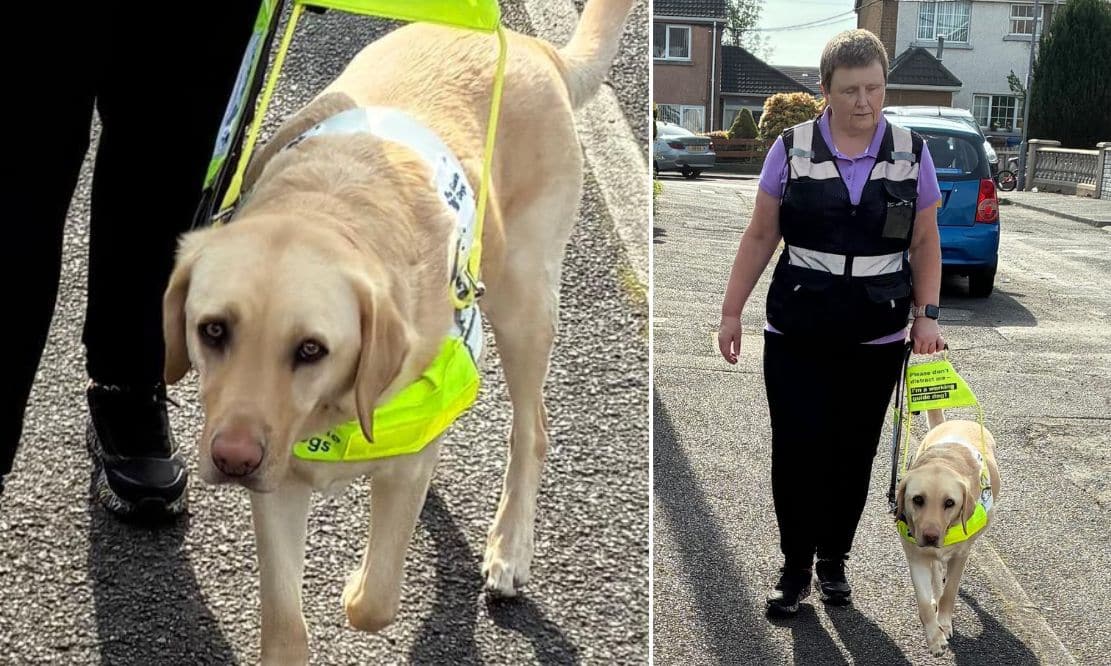
On the last Wednesday of every April is International Guide Dog Day – so today, April 30 – guide dogs across the country are being celebrated for their incredible contributions to enhancing the lives and independence of those living with visual impairments.
One lady from Moy, County Tyrone knows first hand the difference a guide dog can make. Barbara Wilson is now celebrating just over one year with her newest guide dog, June.
Barbara – who is registered as legally blind – has had five guide dogs in the last 32 years starting with Hester in 1993.
At the time Barbara had commenced study at Coleraine University where a whole, new world had opened to her. The experience, however, also brought a number of fresh challenges.
Barbara had managed to get through school life largely without the use of a cane. But at university with the bigger building, new surroundings and hoards of students she found she had no other option but to start using the aid.
Speaking to Armagh I, Barbara explained: “I only really started using it when I went to university because I had to. It was a big building, you’re on your own and no-one else there was blind so I had to be careful what I was doing.”
However, she personally found the cane to have a number of drawbacks finding it all-in-all to be quite an “isolating” experience.
“I find people won’t really approach you when you’re using a cane,” said Barbara. “I got around OK but I found it was a bit more of a struggle. You have to concentrate a lot more when you have a cane so you’re not really paying attention to what’s going on around you.
“It’s not as easy to communicate with people because you’re concentrating so much. But with the dog, the dog is doing a bit of the work as well so you’re not focussing as much on where you’re going. The dog made it a lot easier to get around, you felt a bit more confident going somewhere you didn’t know. I always thought, I’ll try it and if I get lost I’ll get the dog to find a door or a way out. I’ll manage somehow.”
Once Barbara started working with Hester not only did she become more confident, she also found that people were much more receptive and aware of her condition. They would instinctively allow space and were more open to conversation.
“People speak to you a lot more when you have a dog,” she said. “People are interested in the dog and they tend to move out of your way when they see you coming. They seem to recognise that you need the space when you’re with a dog, more so maybe than when you have a cane.
“Is there something about the cane that makes you look less inviting or something? I don’t know. When you have the dog maybe you look more relaxed?” she asked.
No matter the reason, it was a welcome change.
Today, Barbara is enjoying spending time with June and says of her settling in period: “You would think she had been here all her life!”
As a handler with over three decades of experience, Barbara testifies to each dog having their own personality – despite all being trained to the same standards.
She said: “Sometimes guide dogs change their training techniques but the basics are the same. It’s like driving a car – the mechanisms are the same but every car is different.
“Every dog will have a personality, their nature and the way they behave. It doesn’t take that long to adjust. Some of them are just more timid, some are more boisterous and some are more affectionate or enjoy certain things more than others. You can’t expect each dog to behave the same, even working they are all different, they just have their own wee ways and you have to adapt to that.”
Barbara explains that due to a guide dog’s early life and training, they become brilliant at adapting to change.
Typically a guide dog’s journey will begin at around six to eight weeks, when they leave their mother to go to what Barbara referred to as a “puppy raiser”, where they spend the first year of their lives. From there they enter into early training – potentially at another home – before moving into advanced training somewhere else.
And – while they are working dogs – when they are finally at home with their handler and their harness is off, Barbara says, “they are just an ordinary dog”.
Thankfully, at home – and for Northern Ireland as a whole – Barbara has only good things to say about public receptiveness to herself and June when they visit businesses and make use of public facilities.
However, she does acknowledge that there is room for improvement nationally when it comes to understanding the law for the admittance of guide dogs and their handlers to public and private property.
She said: “Nationally and all over the country there is a lot of work to be done. Almost on a daily basis you will hear of someone being turned away when the law clearly states they can’t be.
“It’s a long, long time since I have been turned away. When you live somewhere small like the Moy, you’re known. Everywhere I go in the Moy they are always very welcoming and friendly, with or without the dog. I do know of some restaurants, shops and taxis who will still turn guide dog owners away.
“Somewhere bigger, it might happen more or travelling beyond your local area. I think the more people see guide dogs and as long, as a handler, you make sure the dog is behaving, then it will improve.”
She also has a few helpful dos and don’ts for people who may be unsure of what to do when they encounter guide dogs or those with visual impairment in public.
One of the first and most important points for Barbara, is just to speak. She explains: “Don’t ever not speak to someone because they have a guide dog. I’m just a person, so if you pass someone in the street and say good morning to them say it to me as well.
“It’s also a good idea when you do say hello to someone who is blind to introduce yourself without making a big deal of it so the person knows who you are. Just casually say your name.
“Something that is difficult for me is when people stop you and say, ‘Hello, do you know who I am?’ That can be embarrassing for a blind person. You might think it’s funny but when that happens so many times it can be embarrassing so I would say to people, try not to do that.
“Have a normal conversation like you would with anyone else about the weather or telly or whatever.”
And while Barbara is happy to chat, she makes the important distinction between her willingness to engage and her preference for her guide dog, June to be given some space.
She adds: “You shouldn’t speak to the dog. If you’re standing talking to me and I have the handle down, if you want to ask me, ‘Can I pet your dog?’, and I say, ‘Yes’, then you can pet the dog.
“But don’t give it a big fuss or anything. Some dogs can get very excited or distracted when people talk to them or pet them or maybe I have already been stopped by 10 people that day. I would try not to ask if you can pet the dog but if you really want to then just ask me first.
“It’s important not to speak to the dog when I have the handle in my hand and we’re walking because the dog is working. My safety depends on that dog and the dog also depends on me for safety. It’s difficult to say no to someone but it’s very important. If you ask and the person says no then you should try to be respectful of that.”



